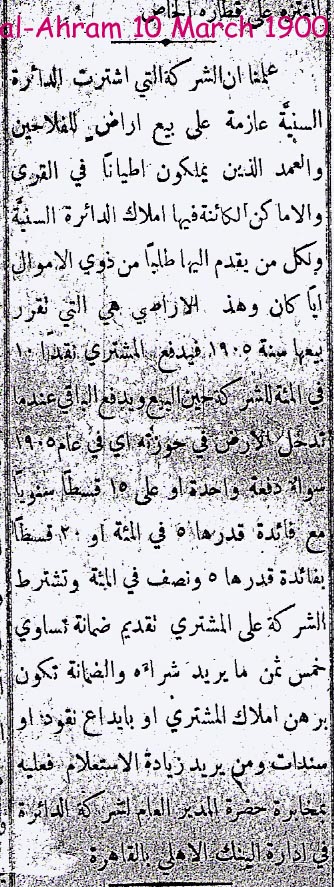 Privatization in Egypt has a sense of newness about it, but close observers of the nation's history know that we've been down this road before and perhaps more boldly. The sell-off 99 years ago of Daira Sanieh, the country's largest state-run company of the 19th century, is a case in point.
Privatization in Egypt has a sense of newness about it, but close observers of the nation's history know that we've been down this road before and perhaps more boldly. The sell-off 99 years ago of Daira Sanieh, the country's largest state-run company of the 19th century, is a case in point.
The landmark sale of Daira Sanieh not only removed 100 percent of the agricultural conglomerate to the private sector, but also involved the founding of the National Bank of Egypt, created a local landed gentry and sparked an unprecedented era of economic well-being. Not bad for a single anchor-investor deal!
Somehow circumstances leading to the deal echo those that led to the reforms of the 1990s.
In the 1870s, Khedive Ismail's private and public debts had reached £E 91 million, plunging the country into receivership. A system of "dual control" was introduced, whereby Egypt's finances were run by a joint Franco-British administration. The khedivial estate of Daira Sanieh, which had been used as a collateral for one of the ruler's loans, was then run by a government-appointed board. After 20 years of government management under this arrangement, Daira Sanieh was still in the red.
Still, everyone agreed the Daira had unlimited potential. Not only did it comprise some of the best sugar plantations in Upper Egypt, but its infrastructure was second to none. It included 470 kilometers of railroads, 65 locomotives and 2,092 wagons, nine sugar mills, substantial irrigation and drainage canals, Nile steamers, tugs and barges, warehouses, crops in the fields, cattle and even entire towns. With sound administration, the thinking ran, a privatized Daira Sanieh could become the inspiration for and engine of a rejuvenated economy.
On June 21, 1898, an arrangement was reached whereby the government sold the Daira Estates to an inter-national consortium led by London's Sir Ernest Cassel for the sum of £6,431,500 sterling, representing the Daira's outstanding liabilities. This singular transfer of ownership and control from a state-owned enterprise to the private sector would change the economic and social face of Egypt for at least the next 60 years. The kickoff started four days after the sale when, on June 29, 1898, three out of the four new owners of Daira Saneih created the National Bank of Egypt, which served as the country's regulatory and issue bank until 1960. (The four owners of Daira Sanieh: Ernest Cassel 50%, Ernest Cronier 12.5%, Raphael Suares 25%, M. Cattaui 12.5%)
These two developments on the privatization of Daira Sanieh and the creation of the bank were part of a plan conceived by Egypt's de facto ruler, Sir Evelyn Baring (the British Consul in Egypt) along with Cassel and his powerful banking allies. With the Daira lands in hand, the consortium proceeded to develop the first generation of modern agro-industrial concerns in Egypt as well as, indirectly, the Aswan and Qena dams. The enterprises created massive numbers of jobs and lucrative export markets. The dams provided cheap electricity and established Egypt's first system of perennial irrigation.
As a result, the value of the consortium's land rose so sharply that when the group sold Daira's agricultural properties on the open market, the revenues exceeded the outstanding portion of the consortium's loan, leaving a huge profit on the transaction. To this end the company split with the government so that the latter could finally liquidate the debt for which the Daira Sanieh had been held collateral. The consortium continued to strip assets by selling off the Daira's sugar mills, railways and rolling stock to its newly incorporated sugar refinery, which became Egypt's largest industrial concern.
The sale of the remaining Daira Sanieh lands (about 300,000 feddans) between 1900 and 1906 also indirectly created the first generation of large landowners and entrepreneurs from outside the foreign and Turco-Circassian classes. The Omdas, Sheikhs al-Balad and effendis who became wealthy landowners, entrepreneurs and brokers were branded the nouveau riche of their time, and were the forerunners of Egypt's intelligentsia, politicians and civil servants.
Privatization, then as now, was not without its opponents, especially those in patronage posts and living comfortably under the old quasi-public regime. Although some of their cries of foul play were justified, capitalism had won the day. The country had set off full throttle toward a modern era. New capital markets were about to be created, and Egypt's nominal age of enlightenment, secularization and opportunity was about to begin. Few probably suspected then that a century later Egypt would find itself on the same threshold of change.
To the left we find the signature "J. Gay Lussac". A son of the famous French scientist Joseph Louis Gay-Lussac (1778-1850), Engineer Jules Gay-Lussac worked for the Egyptian government as a director of Daira Sanieh which at the time accounted for 10% of Egypt's cultivated land. He was also a member of the celebrated Institut d'Egypte where he published several works on the use of fertilizer in Egyptian agriculture.
 Privatization in Egypt has a sense of newness about it, but close observers of the nation's history know that we've been down this road before and perhaps more boldly. The sell-off 99 years ago of Daira Sanieh, the country's largest state-run company of the 19th century, is a case in point.
Privatization in Egypt has a sense of newness about it, but close observers of the nation's history know that we've been down this road before and perhaps more boldly. The sell-off 99 years ago of Daira Sanieh, the country's largest state-run company of the 19th century, is a case in point.